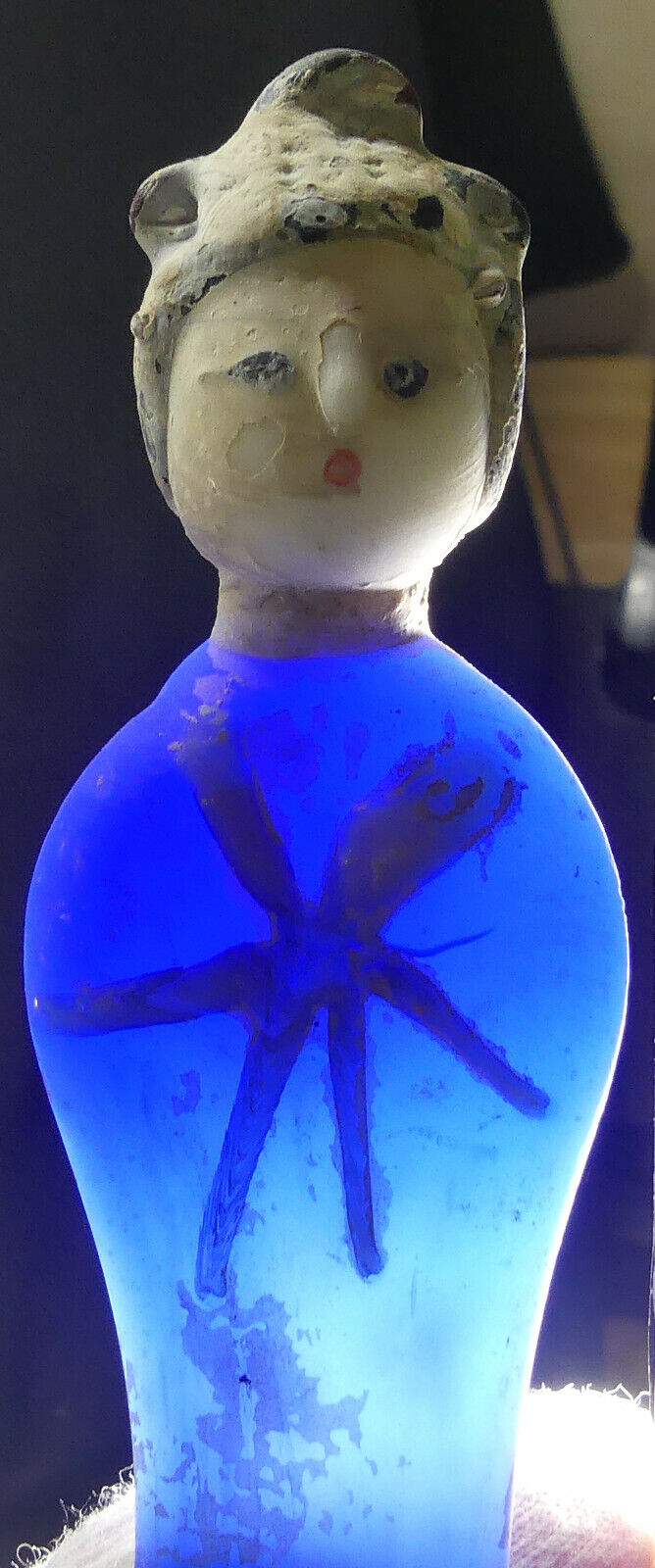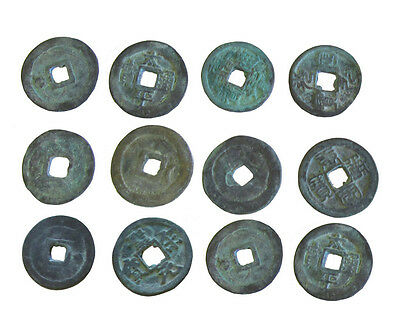-40%
RARE Chinese Wei Dyn. Buddhist Cobalt Blue Glass Goddess Bodhisattva c.386-534
$ 124.08
- Description
- Size Guide
Description
ANCIENT CIVILIZATIONSArtifacts, Antiques, & Fine Collect
i
bles
Ancient Chinese Translucent
Blue
Glass Figurine
Buddhist Goddess—Bodhisattva (Chinese:
菩薩
)
The Eye of Enlightenment—Third-Eye Chakras
Over 1,500 Years Old!
China’s Northern Wei Dynasty
c. 386 AD—534 AD
PROVENANCE/HISTORY
This ancient glass, Buddhist, bodhisattva figurine was obtained from an old collection in China that was moved to Hong Kong. It was reportedly uncovered in China’s Qinghai Province, which is located on the Northeastern part of the Qinghai-Tibet Plateau in Western China.
Included in Qinghai Province are the cities of Golob, Haibei, Hainan, and Haixi.
Historically, the city of Beichan was first built during the Northern Wei period (386-534).
She dates to approximately China’s Northern Wei Dynasty, c. 386 AD—534 AD.
This museum quality piece is Extremely RARE and are Guaranteed authentic and original!
She was previously in a private collection in Qinghai Province. This is the first time it has been offered for sale in the United States.
DETAILS AND CONDITION
This Glass Figure measure approximately 5.
34
” tall x 1.19” wide x .35” in depth (1
36
mm x 30 mm x 9 mm) and weigh about 52 grams or 1.8 ounces. The body of a female figurine, thought to symbolize different Bodhisattvas, is made of transparent glass that has layers of multi-colored, translucent glass layered on top of the molded glass figure.
The glass figure was made in a mold and one can still see the pontil mark (also called a punt mark or scar) where the glass bodhisattva was removed from the pontil rod used to blow the glass was removed from the figure over 1,500 years ago!
This figure is made from stunning Cobalt Blue glass that is a spectacular!!
When held up to a strong light, the colors and rich blue color are breathtaking!
See back-lite macro photos for details!
The term
'bodhisattva'
literally means 'one who has enlightenment as his/her essence', from
bodhi
(awakening or enlightenment) and
sattva
(essence).
It is not simply another term for a Buddha; rather a bodhisattva is a being who is destined for enlightenment rather than one who has gained it already.
Their slender hourglass shaped body wears a simple, floor-length robe that appears to be tied at the waist.
All Bodhisattvas have elaborate hair styles and their eyes are black.
They wear red lipstick and each woman has the traditional Buddhist red mark (called a
bindi
) on her forehead to symbolize her “Third Eye Chakra”—the Eye of Enlightenment. (see below for more details)
Each figure wears a thin robe and each one has its arms crossed across its chest, likely in preparation for their journey to enlightenment and the afterlife.
She has yellow arms, belt, and slippers.
Each figure has an original and authentic coating of minerals, such as white, calcium deposits that are common for objects of this age, and earthen encrustation from having been buried in the damp earth for over 1,500 years.
Each figurine is a work of art and they are all truly museum quality.
There appear to be no repairs or restorations on any of the figures.
To have even one of these glass bodhisattvas in a museum or private collection is remarkable!
I do have several other colors available. Please check my other listings or ask me.
BUDDHISM IN CHINA
Buddhism arrived in China around the 1st century AD and introduced new types of art into China, particularly in the area of statuary. Upon receiving this distant religion, strong Chinese traits were incorporated into Buddhist art. The first Buddhist sculpture is found dating from the Three Kingdoms period during the 3rd century, while the sculpture of the Longmen Grottoes near Luoyang, Henan Province of the Northern Wei, 5th and 6th century has been widely recognized for its special elegant qualities.
This glass Bodhisattvas was recovered in Luoyang, Henan Province and dates to about the 5
th
century AD.
In the 5
th
to 6
th
centuries, the Northern Dynasties, developed rather symbolic and abstract modes of representation, with schematic lines. Their style is also said to be solemn and majestic. The lack of corporeality of this art, and its distance from the original Buddhist objective of expressing the pure ideal of enlightenment in an accessible and realistic manner, progressively led to a change towards more naturalism and realism, leading to the expression of Tang Buddhist art starting in the 7
th
century.
In the second half of the sixth century, China, long divided into north and south, is further subdivided into the northwestern and northeastern regions ruled by different factions of the once-powerful Northern Wei empire. The reunification of China under the subsequent Sui and Tang dynasties initiates a period of prosperity, trade relations, and far-reaching influence. Chang'an, their capital, was one of the largest and richest cities in the world. Art and literature flourish, reflecting influences from the different cultures with which China maintains diplomatic and trade relations. In addition to painting and calligraphy, Tang is noted for its Buddhist sculpture, metalwork, and ceramics, both brightly glazed tomb figures and white-bodied vessels. After the fall of the dynasty in 907, China is once again divided into north and south, ruled by competing dynasties and kingdoms.
In Mahayana and Vajrayana Buddhist thought, a bodhisattva (Chinese:
菩薩
; pinyin:
púsà
; Japanese pronunciation:
bosatsu
; Korean pronunciation:
bosal
) is a being who is dedicated to achieving complete Buddhahood. That is their reason for "being" or raison d'être. Conventionally, the term is applied to beings with a high degree of enlightenment. Bodhisattva literally means a "
bodhi
(enlightenment) being" in Sanskrit. Mahayana practitioners have historically lived in many other countries that are now predominantly Hindu, Muslim or Theravada Buddhist; remnants of reverence for bodhisattvas has continued in some of these regions.
{Reference: Wikipedia}
Similar examples can be found in China’s famous Palace Museum in Beijing or in the National Palace Museum in Taipei and at the MET see Qing Dynasty Jade Zodiac set in Display Gallery 222.
COLOR SYMBOLISM IN BUDDHISM
Buddhism traveled from India into China during the 1st century AD, becoming part of Chinese life and culture alongside the other established belief systems. Statues and Buddhist-related figures like these were commissioned by followers and used during worship.
The colors used in this glass figurine were not chosen just for their beauty, but also for their symbolism in the Buddhist religion. Color symbolism is used in a wide variety of fascinating ways in Buddhist art and ritual.
In Buddhism, each of five colors (
pancha
-
varna
: which are Blue, Black, Red, Green and Yellow) symbolizes a state of mind, a celestial Buddha, a part of the body, a part of the
mantra
word Hum, or a natural element. It is believed that by meditating on the individual colors, which contain their respective essences and are associated with a particular Buddha or bodhisattva, spiritual transformations can be achieved.
Each figurine has their eyes closed in meditation and the classic vermillion red dot on her forehead.
The
urna
(also called a
bindi
) is the dot on the Buddha’s forehead that symbolizes his special wisdom.
According to Wikipedia, a woman had the classic the red dot on her forehead to symbolize the Third Eye, through which she could see the world most clearly.
From Vedic times, this bindi was created as a means to worship one's intellect. Therefore, it was used by both men and women to add in the search of wisdom and truth. In meditation, this very spot between the eyebrows (Bhrumadhya) is where one focuses his/her sight, so that it helps concentration. Most images of Buddha or Hindu divinities in meditative pose with their eyes nearly closed show the gaze focused between eyebrows.
The worship of intellect was in order to use it to ensure their thoughts, speech, actions, habits, and ultimately their character would become pure.
A strong intellect was thought to allow one to make noble decisions in life, to be able to stand up to challenges in life with courage, and to recognize and welcome good thoughts in life. The belief was that on this foundation, a strong individual, a strong family and a strong society can be formed.
REFERENCES:
Chinese History Museum in Beijing contains an outstanding collection of early Chinese glass objects, including a small aqua cup that was found in a Han Dynasty tomb in Guangxi Province, China.
See “
Ancient Glass Research Along the Silk Road
” Edited by Gan Fuxi (Chinese Academy of Sciences & Fudan University, China), Robert Brill (The Corning Museum of Glass, USA), & Tian Shouyun (Chinese Academy of Sciences, China). This book states that ancient Chinese glass from the Eastern Han Dynasty to the Tang Dynasty (200-700 AD) contained High Lead Silicate or PBO-SiO
2
.
Although chemical tests have not been run on these 5 glass figures, it is believed that they all are made from this glass composition.
The Qinghai Museum is located at No.4 Weimin Alleyway, Xining.
Over 10,000 items are displayed, including a collection of Han Dynasty artifacts, Mongolian pottery, Tibetan mani-stones (stones carved with religious prayers and images), and glass figurines like this set of glass figurines.
See “
Scientific Research in Early Chinese Glass
” author: Robert H. Brill and John H. Martin, editors, 1991.
Kwan, Simon;
Early Chinese Glass
; Hong Kong, 2001. ISBN. 9627 101524
Wikipedia
Bid with confidence--as I have Positive Feedback from hundreds of satisfied customers from around the world!
Please look carefully at the photos, taken with macro lens, since they are part of the description. Some photos taken indoors with a strong back light to show the beauty of the translucent glass figures.
They
would make a
wonderful
addition to your collection or a Super gift!
The stand and ruler are not part of the auction, just there to give you a perspective and a good view of item.
And please ask any questions before you buy.
Thanks!

















